Gunvalkyrie Preview
We report on the status of Smilebit's Xbox action game.
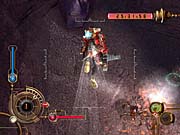
Gunvalkyrie is definitely nearing completion, and judging from the 70 percent build we have in-house, it's safe to say that it's gearing up to be one of the more interesting Xbox games to date. It also seems to be one of the trickiest to get used to, from a gameplay standpoint. It simply doesn't play like any third-person action game you've ever seen, and if you approach it as one, you'll likely be quite frustrated. But if you try to forget what you know about over-the-shoulder games and approach Gunvalkyrie on its own terms, you'll likely get into its quick pace and unique play scheme.
Gunvalkyrie's premise is pretty batty. It's set in the British Empire in the 19th century--a society right on the cusp of a scientific revolution. A certain Dr. Hebble has made a rash of exciting discoveries, which quickly and radically change the world. Advances in energy lead to advances in transportation and medicine, and the lives of all the world's people are improved as a result. Thereafter, space travel becomes a reality. But something is amiss with the good doctor; from his refuge on the distant planet Tir-Na-Nog, not a peep is heard. Soon, though, it is learned that the colonists of Tir-Na-Nog are being brutally slaughtered by the planet's native inhabitants--giant flesh-hungry insectoids. And it is no secret that Dr. Hebble had more than a bit to do with this as well. You, in the role of Kelly, the doctor's daughter, and Saburota, a grim and deadly warrior, must travel to Tir-Na-Nog, discover the whereabouts of the doctor, destroy the insects, and rescue the settlers.
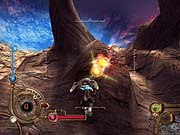
As we reported last week, Gunvalkyrie's structure is essentially mission-based. After you complete each mission, one or more new ones will open up, all of which must be cleared before the next set becomes available. Though it's possible that you'll be able to return to earlier missions later in the game, our experience thus far has not allowed us to do so. The missions themselves are fairly straightforward, albeit pretty nonlinear, with some nicely expansive environments. The bulk of the action is a mix of combat with quite a bit of platforming thrown in. But due to the game's unique mechanics, you'll have to approach the simple act of platforming a bit differently from what you're used to. Because you'll be controlling a character that's equipped with a powerful jetpack, you'll boost horizontally much more often than you'll jump, in the traditional sense. This proves to be pretty satisfying, from a gameplay standpoint, once you get past the unorthodox control mechanics.
Many of you who've encountered Gunvalkyrie have reported having some difficulty with the control scheme. This is because the game looks, for the most part, like a standard third-person action game but doesn't really control anything like one. So if you try to play it as you would, say, Tomb Raider, you probably won't be too successful.
Crucial to playing Gunvalkyrie to any effective degree is mastering the boost mechanics. There are two kinds--a vertical boost, which serves as a jump, and a horizontal boost. The vertical boost can be executed from any point in the air, as well as on the ground. You'll use this to clear distance, but you can also use it as an offensive tool--since you can shoot while in the air, this boost will serve you quite well when the situation calls for speedier assaults. To clear some of the game's trickier environments, you'll have to use both types of boosts. Luckily, they're pretty conveniently mapped--the vertical boost is mapped to the left trigger, and the horizontal boost is mapped to the L3 button. While in the air, you have to sort of ease off the left trigger before a horizontal boost will take effect.
Using either boost will deplete your fuel meter, which, once entirely drained, takes a little more than one second to recharge. While you're basically guaranteed to have a boost handy whenever you need one, you can run out of gas in midair if you aren't careful. That situation could prove pretty unfortunate if you're engaged in midair combat, which you often will be. You see, many of Gunvalkyrie's battles are designed around a swarm philosophy; you'll be on the ground, and a huge group of monsters will swarm quickly in your direction. Since they happen to be on the ground, more often than not the only direction for you to go is up. Because you can control your camera in midair, you can aim downward and fire upon the masses of enemies pretty effectively. This serves as a very good replacement for a strafe mechanic, because you can greatly slow your descent by executing a horizontal dash without entering any directional inputs. And since you can boost at any point in your descent, you'll likely be able to get yourself out of harm's way before landing.
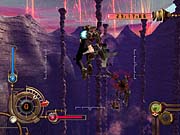
The camera controls are mapped to the right analog stick, and its movement is pretty spazzy and imprecise at this point. It's very difficult to aim at things from a standing position, despite the game's auto lock-on feature. We're hoping that Smilebit will see fit to tweak this a bit before release, as it is really the game's most frustrating kink. Granted, you can avoid the weirdness if you stick closely to the boost-then-fire strategy, but it will certainly rear its head in situations where that tactic won't cut it. In any event, you fire your guns with the right analog stick, and depending on your character, you'll have anywhere from one to three weapons to chose from. Each one is mapped to a face button, so switching between them is instantaneous. Kelly comes equipped with a slow-but-steady rocket launcher that locks on Panzer Dragoon style; a pulse cannon, which acts like a machine gun; and a concentrated energy beam. Saburota, on the other hand, has a more powerful version of the rocket launcher and the same energy beam as Kelly. The differences between the characters are not just in their weapons though--Kelly is much quicker on her feet, while Saburota packs more of a punch and can take more damage.
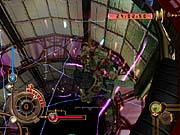
One thing is certain, however: Gunvalkyrie is downright impressive to look at. While you can pick out some sketchy textures if you really try to, the fact that the game runs at a blazing frame rate while displaying swarm upon swarm of horrifying creatures is a testament to the power of the Xbox's innards. The character models are nicely detailed, and they're rendered in a very cool style. Looking at close-ups, you can spot some hints of what look like light cel-shading used to accentuate their details. The models are also quite tastefully self-shadowed.
The environments are very nice looking, not to mention huge. Many are located on the planet's surface and are characterized by huge canyons, wild vegetation, and ruined settlements. There are huge fungal growths that serve as the game's platforms, many of which span over 200 feet of virtual space. When you add to this swarms of insects crawling on the faces of cliffs and swarming overhead dropping death from above, you start to understand how intense these scenarios can get. Other stages take place indoors, within occupied structures. These stages feature more confined spaces, still-active security systems, and swarms of insectoid monstrosities. Still other stages take place in the planet's interior, inside of magma-filled caves full of all manner of precarious surfaces. These particular stages are very atmospheric and bring to mind visions of what Metroid's Brinstar would be like if it were rendered in 3D.
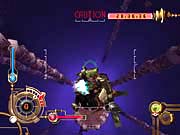
The actual level designs vary greatly as well. Many have you trolling enormous landscapes as you hunt for aliens. Others are more "focused"; one stage, for instance, is shaped like a giant cylinder, which you must traverse from top to bottom, clearing all enemies as you go. On the walls of this stage are pods that transmit harmful electrical energy, and you must destroy them before you can safely descend. One pattern we've noticed is that most stages have simply "destroy all enemies" as their objective. This is pretty disappointing, and we're hoping that things get a bit more eclectic as the game progresses. Our suspicion is that Smilebit had greater plans for the game but was forced to cage them due to time constraints. The game's sparse presentation, in terms of narrative cutscenes and the like, further these suspicions. Again, though, the game is only 70 percent complete, so these things might be resolved in the end.
If you can get into its nonstandard method of controlling a character from a third-person perspective, then you'll likely get pretty excited about Gunvalkyrie. With more and more games of its sort feeling identical to one another, it's nice to see someone trying to present a new manner of gameplay control. The game is due out next month, and if we get an update from Sega, we'll definitely post impressions for you. Otherwise, wait for our full review next month.
Got a news tip or want to contact us directly? Email news@gamespot.com
Join the conversation